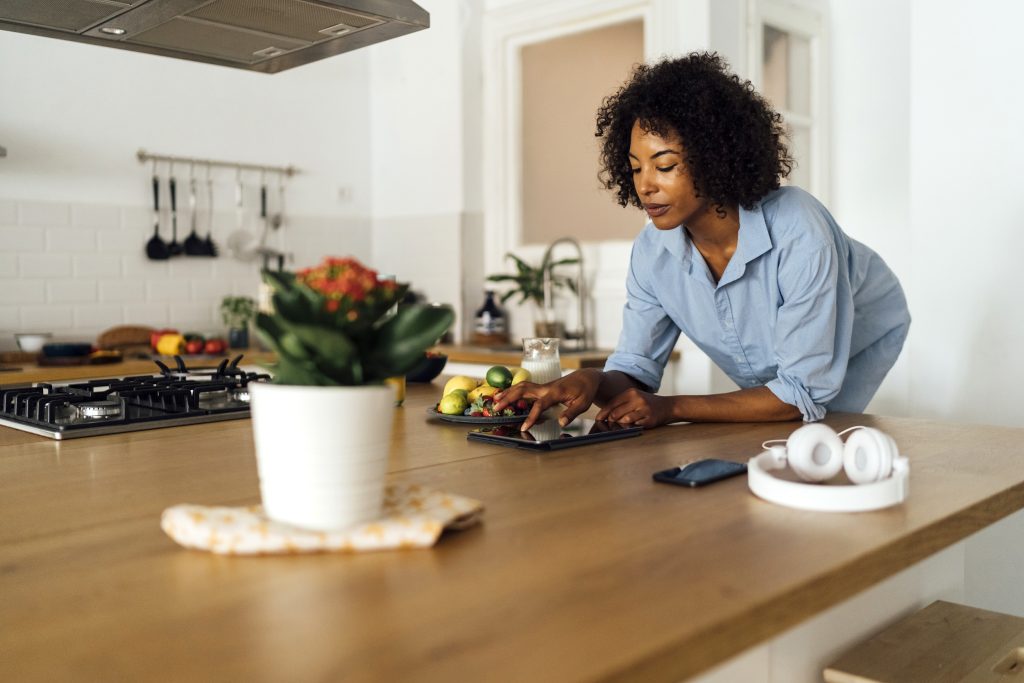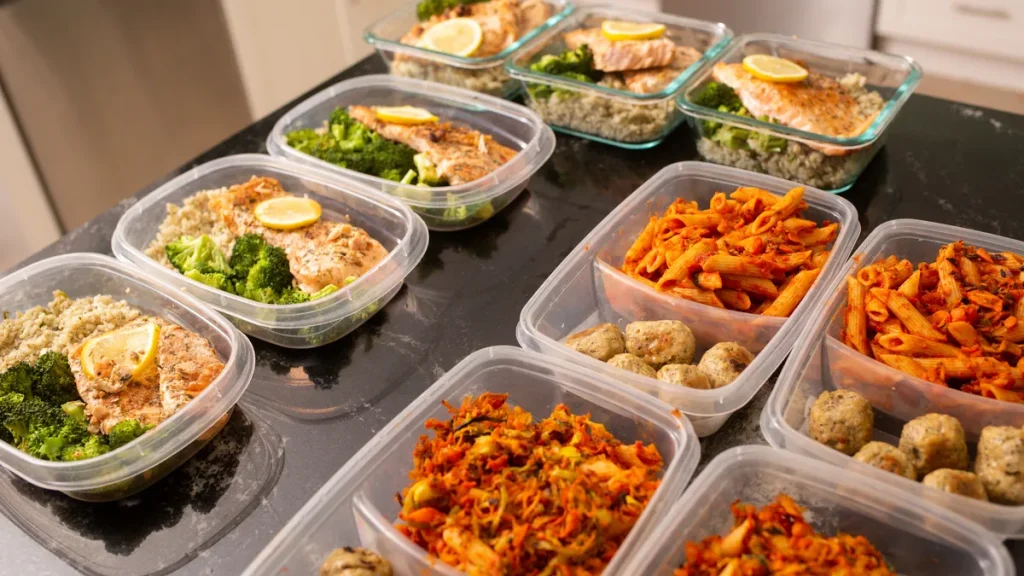
Working from home forces you to develop a different routine than working in an office, especially when it comes to mealtime. Whether you’ve recently been working remotely or have been a remote employee for a while, it’s a great time to learn how to eat healthy at home.
In this guide, we’ll discuss 10 tips for eating healthy while working from home, plus extra advice on healthy eating habits for kids and seniors. Being at home doesn’t mean your healthy routine has to go out the window. Follow the advice below to rebuild or kick-start your healthy habits.
When your home becomes your office, that includes your kitchen. You have access to everything in your fridge and pantry for meals and snack time. With so many options available, it’s easy to fall into poor eating habits. To avoid this, follow these 10 simple tips:
1. Don’t Work in the Kitchen

One of the biggest temptations for eating while working is the easy access to food. If you’re working in the kitchen, you may find excuses to get up and grab a snack. While small, healthy snacks are good if you need them, eating all day won’t improve your health. If you can, set up your desk or work area in an office, bedroom or living room instead of your kitchen or dining room.
Many people also reach for food when they’re stressed, bored or rewarding themselves. Working away from the kitchen can help you avoid heading to the fridge when work gets slow or difficult or when you complete a project. Once you’re working in a different room of your house, try to resist the temptation to go to the kitchen when those moods strike, unless it’s time for breakfast, lunch or a snack.
2. Don’t Eat at Your Desk

When you work from home, it can be tempting to get things done while you eat. However, you should have meals away from your desk to avoid working while eating. If you have a dedicated mealtime and eat away from your desk, you’re more likely to:
- Avoid overeating: Multitasking as you eat can lead to distractions. You may not notice you’re getting full, and if you have too much food on your plate, you may end up eating it all as you’re working.
- Feel more satisfied: When you pay attention to your food as you eat, you’re more likely to notice when you feel full, and that helps you feel satisfied with your meal. You won’t be going back for seconds or snacks in a bit if you focus as you eat and feel satisfied.
- Develop a routine: A day at a workplace is often structured with set mealtimes or breaks, but when you work from home, you may have more flexibility. Try to follow a routine to maintain structure in your workday, even if you’re at home.
- Get up and moving more: When you eat at your workspace, you may have gathered some food earlier and munched on it throughout the day. Getting up to prepare a meal gets you on your feet, which is helpful even if it’s for a bit.
- Make healthier choices: You could be more likely to choose healthier meals if you eat away from your work setup. Eating at a table encourages you to choose healthy meals that may be too messy or inconvenient to eat at your desk.
Designated space and time to eat will help you form healthy eating habits at home and encourage you to focus on your work. Multitasking is difficult for everyone, and if you’re trying to eat while replying to emails or working on other projects, you may be compromising your ability to focus and produce good work.
3. Recognize Your Hunger Signs

If you find it difficult to take time away from your work to eat, you’re not alone. But one way to make sure you avoid overeating and fatigue due to hunger is recognizing when you’re hungry and making time to eat. Some common hunger signs include feeling:
- Tired
- Less Alert
- Less Productive
- Irritable
Certain feelings may represent not only hunger but also the need for certain nutrients since food is essential for mental and physical health. If you’re feeling foggy, you may need more calories. If you’re cranky and tired, you may be lacking magnesium. Eat balanced meals full of the vitamins you need to feel your best, both mentally and physically.
Don’t have any particular hunger signs? Put yourself on an eating schedule and set reminders or alarms, so you know when to take a quick break to eat. You’ll avoid going too long without eating and discovering that you do have hunger signs.
4. Do Some Meal Prep

When you’re working, it can be difficult or impossible to take the time to cook a meal. Avoid the temptation to rely on pre-prepared meals, as those can lack the nutrition you need to stay healthy. Make your own meals to control the portions and ingredients for results that are healthy and tasty.
Working from home opens you up to plenty of meal possibilities, but the endless options can get overwhelming. In other cases, meal prep is useful. Meal prep involves taking time on the weekend or the night before you work to set up convenient yet healthy meals. Meal prep makes quicker work of getting a meal together once it’s time to eat. You’ll only have to reheat or assemble the pieces and enjoy. Here are some tips on how to keep eating healthy with meal prep:
- Research healthy recipes and create a grocery list for the upcoming weeks.
- Prepare beforehand with cooking rice or proteins, making sauces, cutting veggies and more.
- Portion food as you prep to make it easier to prepare when you’re ready to eat.
- Keep your prepped meals in a visible spot in the fridge, so you reach for them instead of unhealthy options.
Label your meals with the date you made them, and be sure to follow safety guidelines for ingredients you’re cooking beforehand, especially meat. If you cook meat over the weekend, make sure you consume it earlier in the week rather than leaving it for long. Many meal prep dishes focus on pre-cooking or prepping less risky vegetables and grains to make lunches like these:
- Rice bowls
- Salads
- Wraps
- Whole grain pasta dishes
- One-pan roasted meals
There is an abundance of healthy meal prep ideas, whether you’re looking for light lunches or filling dinners to get you through the week. Try new recipes to keep your lunches interesting, and experiment with healthy alternatives to see what you or your family enjoy.
5. Eat Meals, Not Just Snacks

Avoid snacking all day and calling that your meal. Even a handful of healthy snacks throughout your workday may not be enough to fuel you, keep you on schedule and help you develop healthy habits. An assortment of snacks can impact your mood, as well, since it won’t contain the nutrients you need from a balanced meal, like:
- Protein
- Healthy fats
- Fiber
- Various vitamins from fruits and vegetables
Remember those essential nutrients when you create your meals, and try to get a bit of everything on your plate instead of grabbing a handful of snacks whenever you feel a little hungry.
6. Don’t Skip Breakfast

Your work from home routine may involve waking up and getting right to work instead of performing your usual morning habits. For many, those habits include eating breakfast, but if you’re skipping that in favor of diving into your day, you may want to rethink your routine. Breakfast is a vital part of your morning routine because it gives you the fuel you need to start your day.
Even if you don’t want to eat right when you wake up, you can still enjoy a small breakfast a few hours before your scheduled lunchtime. Keep it simple with fruit, or go for healthy options with oatmeal or homemade granola bars.
7. Snack Smart

It’s hard to avoid snacking, and sometimes, it gives us the boost of energy we need to get through the day. Between lunch and dinner is an especially popular time to snack since it gives you that final burst to finish your work and cook dinner. Follow a few tips to make healthier snack time choices:
- Don’t buy junk food or have it in the house.
- If you do have junk food in your kitchen, keep it hidden in cabinets to avoid temptation.
- Put healthy snack options in front of the unhealthy ones, so you’re more likely to choose them.
- Prepare healthy snacks when you do you meal prep for the week.
Healthy Snacks While Working From Home
If you do get a craving for sweet and salty foods, go with healthy snack alternatives. Instead of candy, have a smoothie, frozen grapes or other fruits. Instead of chips, try lightly salted nuts or unsalted whole-wheat pretzels. Try to cut out the refined sugars and added salt whenever you snack, and try to avoid snacking at your desk.
8. Portion Your Food

When you eat lunch at your workplace, you bring a specific amount from home to eat. At home, you don’t have that same level of control. You can grab a bag of snacks or head back to the fridge for seconds, and that could lead to unhealthy results. Manage how much you eat and avoid overeating by portioning out your food with these tips:
- Follow serving sizes on the packaging.
- Keep in mind your specific dietary needs.
- Consider what else you’re eating that day.
- User smaller plates or bowls.
Everyone’s hunger and dietary needs are different, so remember that serving sizes may not reflect how much you want or need to eat. Instead of eating more of the same thing, mix in different foods that have the essential nutrients and vitamins you need.
9. Avoid Too Much Caffeine

When you’re home, it can be tempting to brew a pot of coffee and drink from it all day, but drinking too much coffee can have unfortunate side effects. Ironically, some of those effects will impact your alertness, concentration and how you awake you feel, with common issues such as:
- Headaches
- Anxiety
- Problem with digestion
- Fatigue
To avoid those issues, limit yourself to a certain number of cups of coffee per day. If you feel like you need caffeine to get through the day, try tea instead.
10. Stay Hydrated

Swap your other beverages for water to make healthier choices. Get a reusable water bottle for your desk and have it filled every morning to encourage you to tip water throughout the day. You’ll consume less caffeine and sugar if you focus on drinking water and stay appropriately hydrated.
How much water you need per day depends on your activity level and what type of foods you eat throughout the day. Listen to your body and drink when you feel thirsty. Take occasional sips from your water bottle rather than drinking a whole bottle in one sitting to maintain hydration.